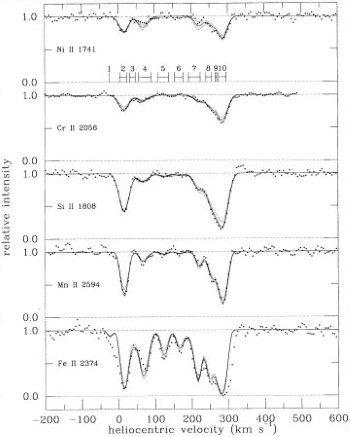 |
TitleInternational Ultraviolet Explorer Spectrum of SN1987A
DescriptionSN1987A is the brightest supernova seen from Earth in several centuries. The abscissa is in kilometers per second (km/sec), and the ordinate goes from 0 to 1 for each panel and reflects the relative strength of each component set. The absorption features shown are predominantly interstellar lines from gas between us and the supernova. However, the supernova is in a nearby galaxy, the Large Magellanic Cloud (LMC). The LMC is just beyond the Milky Way and is moving away from us. The labels above the second spectral strip show groups of interstellar components moving at different velocities, which cannot be resolved separately. The component groups 2, 3, and 4 are in the Milky Way galaxy, and the component groups 5 through 10 are in the LMC. The black dots are the data points, and the black line is a prediction (a model) including all of the subcomponents for what the interstellar spectrum should look like. The model and the data points agree very well. The ions represented are once-ionized nickel, once-ionized chromium, once-ionized silicon, once-ionized manganese, and once-ionized iron. Evidently, the lines of Fe II (bottom panel) are much stronger than the lines of Ni II (top panel). Note that when referring to the spectrum of the element, astronomers use the notation Fe II for the spectrum of once-ionized iron. Likewise, Ni II is used for the spectrum of once-ionized nickel, etc. For more information about this spectrum, see Welty, D. E., Frisch, P. C., Sonneborn, G., York, D. G. 1999, ApJ, 512, 636.
FacilityInternational Ultraviolet Explorer
Subject
Spectral TypeUltraviolet
CreditsSpectrum courtesy Dan Welty. Reproduced by permission of the AAS.
TypeObservation
Associated LessonUltraviolet Science
|